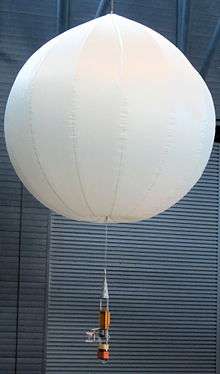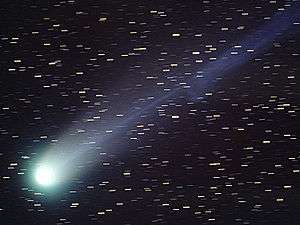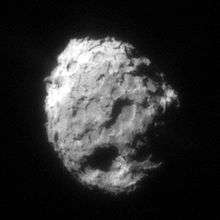Vega 2
|
Vega solar system probe bus and landing apparatus (model) | |
| Names | Venera-Halley 2 |
|---|---|
| Mission type | Planetary Science including lander and atmospheric probe |
| Operator | Soviet Academy of Sciences |
| COSPAR ID |
1984-128A 1984-128E 1984-128F |
| SATCAT № |
15449 15856 15857 |
| Spacecraft properties | |
| Manufacturer | NPO Lavochkin |
| Launch mass |
Spacecraft:4,920 kg (10,850 lb) Balloon:21.5 kg (47 lb) |
| Landing mass | 1,520 kg (3,350 lb) |
| Orbital parameters | |
| Reference system | Geocentric |
| Regime | Low Earth |
| Perigee | 65 kilometres (40 mi) |
| Apogee | 204 kilometres (127 mi) |
| Inclination | 51.5° |
| Period | 88.1 minutes |
| Flyby of Venus | |
| Closest approach | June 15, 1985 |
| Venus atmospheric probe | |
| Spacecraft component | Vega 2 Balloon |
| Atmospheric entry | 02:06:04, June 15, 1985 |
| Venus lander | |
| Spacecraft component | Vega 2 Decent Craft |
| Landing date | 03:00:50, June 15, 1985 |
| Landing site | 8°30′S 164°30′E / 8.5°S 164.5°E |
| Flyby of Halley's Comet | |
| Closest approach | March 9, 1986 |
| Distance | ~3,000 km (1,900 mi) |
Vega 2 (along with Vega 1) is a Soviet space probe part of the Vega program. The spacecraft was a development of the earlier Venera craft. They were designed by Babakin Space Centre and constructed as 5VK by Lavochkin at Khimki. The craft was powered by twin large solar panels and instruments included an antenna dish, cameras, spectrometer, infrared sounder, magnetometers (MISCHA), and plasma probes. The 4,920 kg craft was launched by a Proton 8K82K rocket from Baikonur Cosmodrome, Tyuratam, Kazakh SSR. Both Vega 1 and 2 were three-axis stabilized spacecraft. The spacecraft were equipped with a dual bumper shield for dust protection from Halley's Comet.
Venus mission
The descent module arrived at Venus on 15 June 1985, two days after being released from the Vega 2 flyby probe. The module, a 1500 kg, 240 cm diameter sphere, contained a surface lander and a balloon explorer. The flyby probe performed a gravitational assist maneuver using Venus, and continued its mission to intercept the comet.[1]
Lander
The surface lander was identical to that of Vega 1 as well as the previous six Venera missions. The objective of the probe was the study of the atmosphere and the exposed surface of the planet. The scientific payload included a UV spectrometer, temperature and pressure sensors, a water concentration meter, a gas-phase chromatograph, an X-ray spectrometer, a mass spectrometer, and a surface sampling device. Several of these scientific tools (the UV spectrometer, the mass spectrograph, and the devices to measure pressure and temperature) were developed in collaboration with French scientists.[1]
The Vega 2 lander touched down at 03:00:50 UT on 15 June 1985 at around 7°08′S 177°40′E / 7.14°S 177.67°E, in the northern region of Aphrodite Terra. The altitude of the touchdown site was 0.1 km above the planetary mean radius. The measured pressure at the landing site was 91 atm and the temperature was 736 K. The surface sample was found to be an anorthosite-troctolite rock, rarely found on Earth, but present in the lunar highlands, leading to the conclusion that the area was probably the oldest explored by any Venera vehicle. It transmitted data from the surface for 56 minutes.[2]
Balloon

The Vega 2 Lander/Balloon capsule entered the Venus atmosphere (125 km altitude) at 02:06:04 UT (Earth received time; Moscow time 05:06:04) on 15 June 1985 at roughly 11 km/s. At approximately 2:06:19 UT the parachute attached to the landing craft cap opened at an altitude of 64 km. The cap and parachute were released 15 seconds later at 63 km altitude. The balloon package was pulled out of its compartment by parachute 40 seconds later at 61 km altitude, at 7.45 degrees S, 179.8 degrees east. A second parachute opened at an altitude of 55 km, 200 seconds after entry, extracting the furled balloon. The balloon was inflated 100 seconds later at 54 km and the parachute and inflation system were jettisoned. The ballast was jettisoned when the balloon reached roughly 50 km and the balloon floated back to a stable height between 53 and 54 km some 15 to 25 minutes after entry. The mean stable height was 53.6 km, with a pressure of 535 mbar and a temperature of 308-316 K in the middle, most active layer of the Venus three-tiered cloud system. The balloon drifted westward in the zonal wind flow with an average speed of about 66 m/s at nearly constant latitude. The probe crossed the terminator from night to day at 9:10 UT on 16 June after traversing 7400 km. The probe continued to operate in the daytime until the final transmission was received at 00:38 UT on 17 June from 7.5 S, 76.3 E after a total traverse distance of 11,100 km. It is not known how much further the balloon traveled after the final communication.[2]
Halley mission
After their encounters, the Vegas' motherships were redirected by Venus' gravity to intercept Halley's Comet.
The spacecraft initiated its encounter on March 7, 1986 by taking 100 photos of the comet from a distance of 14 million kilometers.
Vega 2 made its closest approach at 07:20 UT on March 9, 1986 at 8,030 km. The data intensive examination of the comet covered only the three hours around closest approach. They were intended to measure the physical parameters of the nucleus, such as dimensions, shape, temperature and surface properties, as well as to study the structure and dynamics of the coma, the gas composition close to the nucleus, the dust particles' composition and mass distribution as functions of distance to the nucleus and the cometary-solar wind interaction.
During the encounter, Vega 2 took 700 images of the comet, with better resolution than those from the twin Vega 1, partly due to the presence of less dust outside the coma at the time. Yet Vega 2 recorded an 80% power loss during the encounter as compared to Vega 1's 40%.
After further imaging sessions on 10 and 11 March 1986, Vega 2 finished its primary mission. Vega 1 ran out of attitude control propellant on 30 January 1987, and contact with Vega 2 continued until 24 March 1987.
Vega 2 is currently in heliocentric orbit.
See also
References
External links
- Vega 2 Measuring Mission Profile by NASA's Solar System Exploration
- Vega mission images from the Space Research Institute (IKI)
- Raw data from Vega 1 and Vega 2 on board instruments
- Soviet Exploration of Venus




